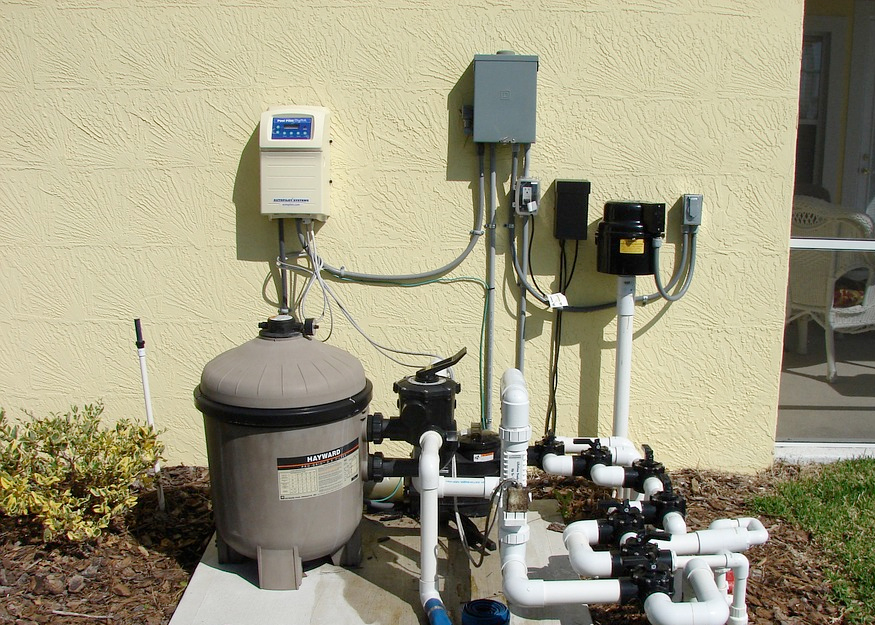
Pool filters are as important to your pool as your kidneys are to your own body. We know that sounds kind of gross, but it’s true. Though chlorine and other sanitizers work to kill bacteria and other contaminants, the filter is what actually removes them from the water. Without it, your pool water would grow cloudy and fill with debris. Not exactly fun for swimming. So how do you choose the best one? It’s not about which one is the least expensive, though cost is certainly a factor. You want a filter that will trap contaminants, be easy to clean and maintain, and last more than just a few seasons. In order to make the best selection for your pool, first get a handle on your options. The first step to choosing the best filter is knowing what your options are. You have three types of filters to choose from: sand, cartridge, and diatomaceous earth, or D.E. Price, replacement frequency, and filtration rates differ by type. And if you’re wondering how to clean a pool filter, that will also depend on the type you select. But before you can accurately compare pool filter types, how well they function, and how much work they require to maintain, you need to know about microns. Pool filters measure the size of contaminants they’re capable of removing in microns. It’s short for micrometer, which is one millionth of a meter. Having trouble picturing just how small that is? A single strand of human hair is about 50 microns, or about .05 millimeters in diameter. Some bacteria measures about 2 microns, or about .002 millimeters in diameter. Whether they’ve been killed by chlorine or not, bacteria and other contaminants can only be filtered out if the filter media—the material that actually does the filtering—is fine enough to collect those teeny, tiny particles. Sand Filters If you’re on a budget, and you want to spend minimal time on maintenance, a sand filter is the best choice for you. It’s also optimal for large pools because it won’t clog as easily as other filters. Your pool pump sucks water in from the skimmers, then pushes it through a large filtration tank full of sand. The standard media used inside the tank is #20 silica sand. It grabs particles that measure 20 microns and larger . Each grain of sand is, for lack of a better word, prickly. If you could look at it under a microscope, you’d see it has lots of little rough edges all around it, which is how it grabs contaminants and debris that pass through the filter. As weeks and years pass, and more water flows through the filter, those rough edges are slowly worn down by erosion, eventually becoming smooth surfaces that aren’t able to capture anything. At the same time, the particles trapped within the sand will build up over the life of the filter. This can actually help trap smaller particles, even as the sand itself begins to smooth out. But eventually, it will prevent proper water flow through the filter, reducing the filter’s efficiency. A pressure gauge on the side of the filter will alert you to increasing internal pressure—a sign it’s time to backwash the filter. This easy cleaning method the filter reverses the water flow, flushing all the debris to waste. Because the silica captures particles of 20 microns or larger, you’ll really need to stay on top of your pool water chemistry. If there’s not enough sanitizer in your pool to kill those tiny, 2-micron bacteria, a sand filter isn’t going to catch them either, and they’ll be floating around in your pool with you. Sand Alternatives Although #20 silica is the standard media in sand filters, you can slightly increase filtration efficiency by adding D.E. powder after backwashing or replacing the sand. You can also entirely replace the silica with one of two alternatives. ZeoSand: This is made from a mineral called zeolite. You need only half as much (by weight in pounds) as standard pool filter sand. It’s crystal-like shape naturally traps smaller contaminants than silica. This improves water clarity and requires less frequent backwashing. ZeoSand lasts about five years, so its lifespan is similar to silica. Filter Glass: This is finely crushed, recycled glass. Don’t worry about cuts—it’s smooth to the touch. It has a negative electrical charge which attracts positively charged particles, such as iron and manganese. You can use about 20% less filter glass than you would silica, while filtering debris as small as 5 microns . It also lasts up to three times longer than pool sand.
